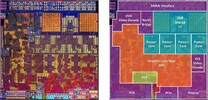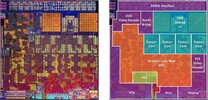AMD A4 Micro-6400T vs AMD A10 Micro-6700T
AMD A4 Micro-6400T
► remove from comparison
The AMD A4 Micro-6400T is a mobile quad-core SoC (codenamed "Mullins") for tablets, which has been presented in April 2014. In addition to 4 CPU cores clocked at 1.0 - 1.6 GHz (boost clock), the 28 nanometer chip also integrates a Radeon R3 GPU, a single-channel DDR3L-1333 memory controller and the Southbridge with various I/O-ports.
Architecture
Both Beema (for notebooks) and Mullins (for tablets and compact subnotebooks, same die) are based on AMD's Puma+ architecture, which is the successor to the previous Jaguar design (Kabini and Temash APUs). Neither the performance per clock nor the feature set (including SSE up to 4.2, AVX and AES) have been modified. However, AMD managed to reduce the leakage current, enabling significantly higher (boost) clock speeds. This leads to a more responsive system and better overall performance. As its predecessor, the chip is manufactured in 28 nm.
Performance
In single thread tasks, the APU performs slightly better than the former A4-5000 (15 W, 1.5 GHz), but clocks and performance will decrease substantially in long-lasting multi-thread benchmarks. Overall, performance is similar to a Celeron N2920. Nonetheless, the Micro-6400T will be sufficient for simple workloads like Office, Internet browsing and multimedia.
Graphics
The SoC integrates a Radeon R3 GPU with 128 shaders, which is based on the GCN architecture and clocked at up to 350 MHz. On average, the graphics performance is similar to Intel's HD Graphics (Ivy Bridge) or a Radeon HD 8250. Current games (as of 2014) are thus hardly playable even in low settings, only a few older and less demanding titels will run fluently.
Power Consumption
The power consumption of the entire SoC is rated at 4.5 watts TDP (SDP: 2.8 W). Thus, the APU is suitable for passively cooled tablets.
AMD A10 Micro-6700T
► remove from comparison
The AMD A10 Micro-6700T is a mobile quad-core SoC (codenamed "Mullins") for tablets, which has been presented in April 2014. In addition to 4 CPU cores clocked at 1.2 - 2.2 GHz (boost clock), the 28 nanometer chip also integrates a Radeon R6 GPU, a single-channel DDR3L-1333 memory controller and the Southbridge with various I/O-ports.
Architecture
Both Beema (for notebooks) and Mullins (for tablets and compact subnotebooks, same die) are based on AMD's Puma+ architecture, which is the successor to the previous Jaguar design (Kabini and Temash APUs). Neither the performance per clock nor the feature set (including SSE up to 4.2, AVX and AES) have been modified. However, AMD managed to reduce the leakage current, enabling significantly higher (boost) clock speeds. This leads to a more responsive system and better overall performance. As its predecessor, the chip is manufactured in 28 nm.
Performance
In single thread tasks, the APU should be even faster than the former A6-5200 (25 W, 2.0 GHz), but clocks and performance may decrease substantially in long-lasting multi-thread benchmarks. Nonetheless, the Micro-6700T should be sufficient for daily workloads like Office, Internet browsing and multimedia.
Graphics
The SoC integrates a Radeon R6 GPU with 128 shaders, which is based on the GCN architecture and clocked at up to 500 MHz. On average, we expect the graphics performance to be similar to Intel's HD Graphics 4000 (ULV versions) or a Radeon HD 8330. Current games (as of 2014) are thus hardly playable even in low settings, only a few older and less demanding titels should run flawless.
Power Consumption
The power consumption of the entire SoC is rated at 4.5 watts TDP (SDP: 2.8 W). Thus, the APU is suitable for passively cooled tablets.
| Model | AMD A4 Micro-6400T | AMD A10 Micro-6700T | ||||||||||||||||
| Codename | Mullins | Mullins | ||||||||||||||||
| Series | AMD AMD A-Series | AMD AMD A-Series | ||||||||||||||||
| Series: AMD A-Series Mullins |
|
| ||||||||||||||||
| Clock | 1000 - 1600 MHz | 1200 - 2200 MHz | ||||||||||||||||
| L1 Cache | 256 KB | 256 KB | ||||||||||||||||
| L2 Cache | 2 MB | 2 MB | ||||||||||||||||
| Cores / Threads | 4 / 4 | 4 / 4 | ||||||||||||||||
| TDP | 4.5 Watt | 4.5 Watt | ||||||||||||||||
| Technology | 28 nm | 28 nm | ||||||||||||||||
| Features | SSE (1, 2, 3, 3S, 4.1, 4.2, 4A), x86-64, AES, AVX, Single-Channel DDR3L-1333a | SSE (1, 2, 3, 3S, 4.1, 4.2, 4A), x86-64, AES, AVX, Single-Channel DDR3L-1333 | ||||||||||||||||
| iGPU | AMD Radeon R3 (Mullins/Beema) ( - 350 MHz) | AMD Radeon R6 (Mullins) (? - 500 MHz) | ||||||||||||||||
| Architecture | x86 | x86 | ||||||||||||||||
| Announced |
Benchmarks
Average Benchmarks AMD A4 Micro-6400T → 100% n=5
Average Benchmarks AMD A10 Micro-6700T → 130% n=5
* Smaller numbers mean a higher performance
1 This benchmark is not used for the average calculation












